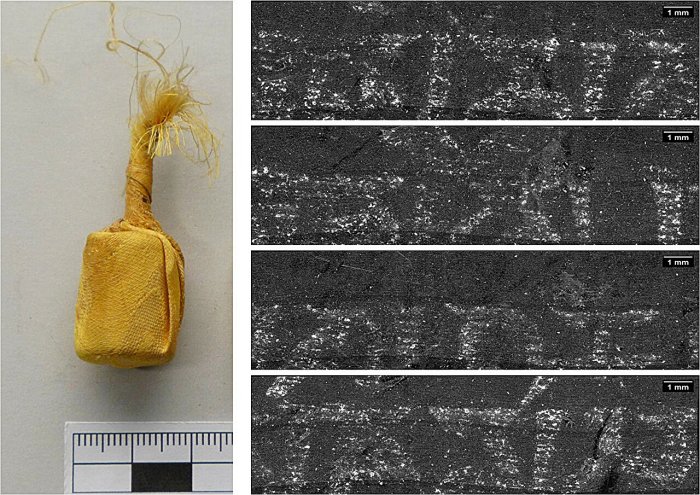Jan Bartek – AncientPages.com – The Mongolian collection at the Ethnological Museum of the National Museums in Berlin houses a distinctive Gungervaa shrine. Inside this shrine, researchers discovered three tiny scrolls wrapped in silk. Utilizing 3D X-ray tomography, a team at HZB successfully created a digital replica of one scroll. Through an advanced mathematical technique, they virtually unrolled the scroll to reveal its scripture—a method also applied in battery research.
The roll is analyzed at BESSY II and can be virtually unrolled. “Om mani padme hum” appears on the unrolled strip. Credit: DOI: 10.1016/j.culher.2025.06.009
Buddhism in Mongolia has evolved unique traditions that are deeply intertwined with the country’s nomadic culture. Many families possessed portable shrines that accompanied them on their travels. These shrines often contained statues, images, decorative objects, relics, and small rolled scrolls inscribed with prayers called “dharanis.” Unfortunately, during the revolutionary period from 1921 to 1930, this cultural practice faced near extinction as numerous shrines were destroyed.
One such shrine found its way to Germany and was preserved in the archives of the Ethnological Museum in Berlin. Its origins remained largely unknown until Birgit Kantzenbach, a restorer at the museum, began investigating it several years ago. She discovered that nothing was organized; fabric flowers, relics, small statues, and three small scrolls were scattered within it. Her research journey led her to Mongolia for further exploration into its history and significance.
The image on the left shows the scroll at the BAMline at BESSY II. On the right is a reconstructed cross-section of the scroll. Traces of metal containing ink appear light in color, while the paper is gray and the air is dark. Credit: DOI: 10.1016/j.culher.2025.06.009
“An object always means only what people see in it; that’s what’s important,” she says. She then turned to HZB physicist Tobias Arlt to examine the small scrolls wrapped in silk.
Until recently, the standard practice for examining scrolls involved unwrapping and unrolling them to inspect any inscriptions. However, this method poses a significant risk of damaging the material and causing irreversible alterations. To address this issue, Tobias Arlt conducted an examination of the Dharani scrolls using advanced tomography techniques at the Federal Institute for Materials Research and Testing (BAM) at BESSY II.
“The high-resolution 3D images show that there are around 50 windings in each scroll, with strips measuring over 80 centimeters that are wound tightly and carefully,” says Arlt.
By employing a mathematical method developed at the Konrad Zuse Institute alongside the Amira software, he successfully managed to virtually unroll the strip from the 3D data of the rolled sample. Initially, this process was time-consuming; however, with advancements in artificial intelligence, it has become significantly faster.
Three tiny scrolls between 3 and 5 centimeters long were found inside the shrine. They are wrapped in silk and glued together. Credit: Staatliche Museen zu Berlin, Ethnologisches Museum / Martin Franken
“We are continuing to optimize this complex process of virtual unrolling,” says Arlt. “We also use this method in our own research, for example to analyze changes in tightly wound or folded batteries.”
In fact, traces of ink were visible on the virtually unrolled strips. “This is interesting because Chinese ink traditionally consists of a mixture of soot and animal glue, but in this case, ink containing metal particles was apparently used,” says Kantzenbach.
See also: More Archaeology News
The characters used are Tibetan, yet the language is Sanskrit, which was an unexpected combination. This resulted in the appearance of the well-known Tibetan Buddhist mantra for universal compassion: “Om mani padme hum.”
The Mongolian Gungervaa shrine is currently on display at the Humboldt Forum in Berlin as part of the exhibition “Restoration in Dialogue,” which is available for viewing until June 1, 2026. Admission to this exhibition is free. Following its time at the Humboldt Forum, plans are in place to exhibit the shrine in Mongolia.
The study was published in the Journal of Cultural Heritage
Written by Jan Bartek – AncientPages.com Staff Writer




